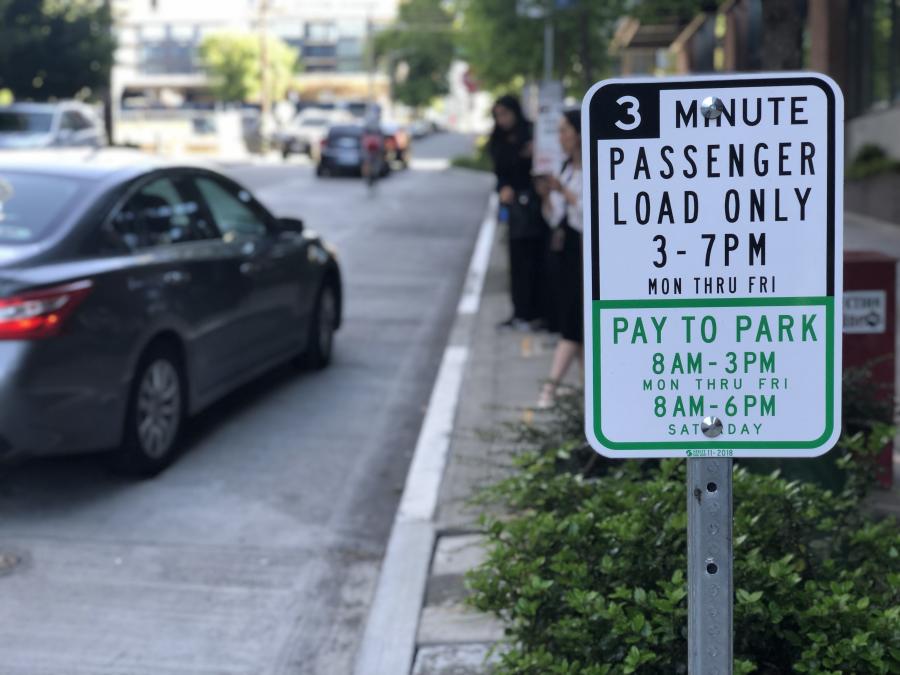
Curbing Conflicts: Study Shows Promise for Curbing Ride-Hail Traffic
SEPTEMBER 5, 2019 — Today the University of Washington Urban Freight Lab released the results of a pilot study on Curb Allocation Change supporting easier and less disruptive passenger pick-ups and drop-offs for ride-hail app vehicles like Uber and Lyft, also referred to as transportation network companies (TNCs). The study tested the traffic impacts of providing more passenger load zones (PLZs) paired with in-app geofencing technology that guided drivers and riders to designated load/unload locations. While limited to a very specific sample, the results indicate that creating a designated space for passenger loading can discourage double-parking and reduce traffic conflicts.
Key findings from this study area indicate that:
- Adding designated loading zones and geofencing increased driver compliance in stopping at the curb. A significant percentage of ride-hail vehicles stop to pick-up and drop-off passengers in the travel lane. Those in-lane stops appear connected to the lack of available designated curb space. Adding designated loading zones and geofencing reduced driver stops in the travel lane to load and unload passengers. But it was not lack of curb space alone that influenced driver activity: between 7 percent and 10 percent of drivers still stopped in-lane even when the zones were empty.
- Combining passenger load zones and geofencing reduced the average amount of time drivers stopped to load and unload passengers. For example, 90 percent of drop-offs took less than 1 minute 12 seconds, which is 42 seconds faster than the average time with the added load zones alone.
- Passenger satisfaction increased when curb space was designated for pick-ups and drop-offs. In the study, the percentage of riders rating their curb experience as very good or excellent went up by 5% for pickups and 34% for drop-offs.
“This research uses a data-based approach to experiment with potential solutions aimed at improving traffic flow while accommodating changing traveler demands. We are proud to provide robust analysis to support this collaborative approach to problem solving; where the public and private sector work together on shared regional challenges.”
— Anne Goodchild, PI, Director, Supply Chain Transportation & Logistics Center
The Urban Freight Lab collaborated with the Sustainable Transportation Lab and the Seattle Department of Transportation (SDOT) to design a data-driven research methodology that combined video analytics, ground observations, user surveys and existing city data to assess a new approach to curbside management in a congested urban environment. SDOT installed additional passenger load zones and coordinated with the service providers to institute a geofence in the area. Data was collected over the course of six weeks on three block faces along Boren Avenue in the South Lake Union neighborhood, an area with considerable congestion and TNC use. This non-arterial side street has 25 mph speed limits, stop signs at each intersection, and high levels of pedestrian activity.
The pilot was sponsored by the Mobility Innovation Center with funding from the Seattle Department of Transportation, Amazon, King County Metro, Sound Transit, and Challenge Seattle. Geofence implementation support was provided by Uber and Lyft.
Like all major cities, Seattle is grappling with how best to manage curb use, mobility, safety and congestion associated with the increasing use of ride-hailing services. According to a 2018 Seattle Times analysis, TNC ridership in the Seattle region has grown to more than five times the level it was in the beginning of 2015, providing, on average, more than 91,000 rides a day in 2018 with the majority of trips concentrated heavily in the city’s densest neighborhoods.
A second phase of the study has been proposed to test the geofence and PLZ strategies in a high traffic, transit corridor so transit managers can learn and compare between the two environments.
READ MORE:
- About Mobility Innovation Center
- About the Sustainable Transportation Lab
- Report: Curb Allocation Change
- Photos from Curbing Conflicts research
- About the Curb Allocation Change research project
- Seattle Tests Passenger Load Zones for Ride-Hail Vehicles Media release
About the Urban Freight Lab (UFL): An innovative public-private partnership housed at the Supply Chain Transportation & Logistics Center at the University of Washington, the Urban Freight Lab is a structured workgroup that brings together private industry with City transportation officials to design and test solutions around urban freight management.
In the media: